Offshore Wind Support Vessels
Note: While the vessels listed below are specialized to wind support roles, the applicable regulations can be found on the support vessels regulatory guidance page. Regulations from 33 CFR Subchapter N for "OCS activities" as currently defined in that subchapter do not apply to wind facilities and supporting activities. Guidance specific to District 8 or oil and mineral operations may or may not be applicable and will require consultation with the local OCMI to determine if particular guidance is applicable to a vessel or operation.
Crew Transfer Vessel (CTV)
T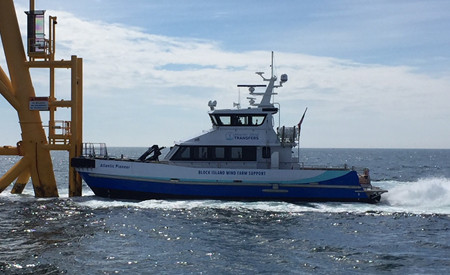 he primary function of a CTV is to ferry small crews to offshore wind turbine installations for day-trip operations and maintenance visits and inspections.
he primary function of a CTV is to ferry small crews to offshore wind turbine installations for day-trip operations and maintenance visits and inspections.
CTVs are Offshore Supply Vessels or Small Passenger Vessels less than 100 GRT and inspected under 46 CFR Subchapters "L" or "T", consisting of hulls that are generally an aluminum, catamaran-type with an average speed of approximately 20 knots. Accommodations include arrangements/seating for up to 36 persons.
Pictured left (Photo credit: U.S. Coast Guard OCSNCOE) is the Atlantic Pioneer ferrying technicians to service the Block Island Wind Farm at Rhode Island. The Atlantic Pioneer was the first U.S. Flagged Jones Act CTV constructed to operate in U.S. offshore wind farms.
Service Operations Vessel (SOV)
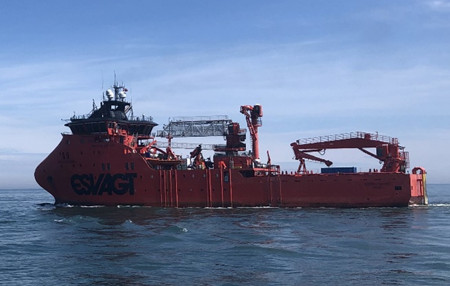 SOVs are fuel-efficient DP-enabled vessels that loiter & operate as in-field accommodations for workers and platform assist for wind turbine servicing and repair work.
SOVs are fuel-efficient DP-enabled vessels that loiter & operate as in-field accommodations for workers and platform assist for wind turbine servicing and repair work.
An SOV can provide accommodations for 40+ personnel.
SOVs are equipped with heave-compensated 'walk-to-work' gangways and small (typically 10-ton) cranes to transfer equipment onto the platform's base. SOVs may include launchable/retrievable daughter-crafts used to ferry turbine technicians to multiple locations on the wind farm.
Pictured (Photo credit: Equinor) is an ESVAGT SOV servicing the Dudgeon Offshore Wind Farm off the east coast of England.
Currently, there are no Jones Act-compliant SOVs.
Feeder Support Vessel (FSV)
FSVs are built and designed to carry deck cargo such as turbines and blades to the installation vessel and can provide accommodations for 50+ personnel.
Pictured (Image credit: 2nd Wind Marine, LLC) is a drawing of an FSV designed by MiNO Marine, LLC for 2nd Wind Marine who will build and operate the vessel.
Currently, there are no Jones Act-compliant U.S. Flagged FSVs.
Wind Turbine Installation Vessel (WTIV)
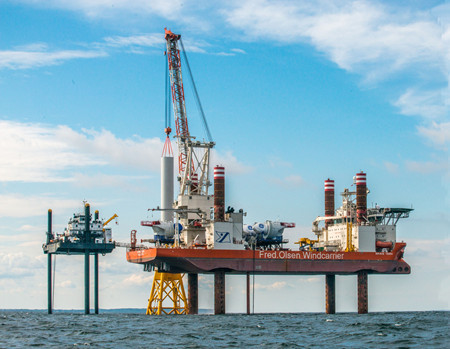 WTIVs provide installation and construction services. While operating in shallow water, WTIVs can self-elevate, as seen in the picture. In deeper water, WTIVs will serve as floating heavy-lift vessels.
WTIVs provide installation and construction services. While operating in shallow water, WTIVs can self-elevate, as seen in the picture. In deeper water, WTIVs will serve as floating heavy-lift vessels.
WTIVs can have accommodations to house 50+ personnel and are equipped with a cargo deck designed to carry turbines, blades, and equipment.
The picture to the left (Photo credit: 2nd Wind Marine, LLC) is a WTIV installing a turbine for the Block Island Wind Farm project.
There are currently no Jones Act-compliant WTIVs in service; however, one is under construction.
Liftboats
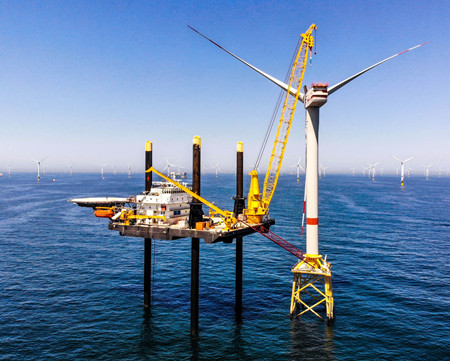 Liftboats are used as SOVs and FSVs in wind farms closer to shore and in shallower waters, such as the Block Island Wind Farm.
Liftboats are used as SOVs and FSVs in wind farms closer to shore and in shallower waters, such as the Block Island Wind Farm.
Liftboats have movable legs capable of raising their hulls above the surface of the sea.
Because of the length of their legs and air gap requirements, liftboats are limited by water depth. Due to this limitation, liftboats generally stay closer to shore.
Photo credit: Falcon Global, LLC (Seacor Marine, LLC)
Field Development Vessel (FDV)
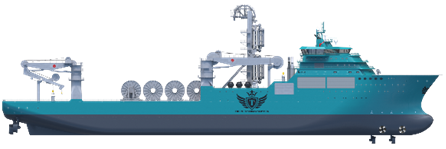 FDVs are designed to lay cables connecting offshore wind structures within the field and cables connecting those structures to the shore, which deliver the electrical energy from the field to the shore.
FDVs are designed to lay cables connecting offshore wind structures within the field and cables connecting those structures to the shore, which deliver the electrical energy from the field to the shore.
Currently, there are no Jones Act-compliant FDVs.
Image credit: Triumph Subsea, Ltd.